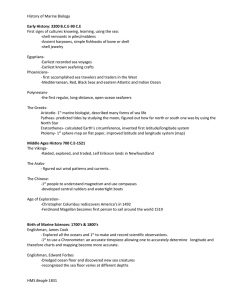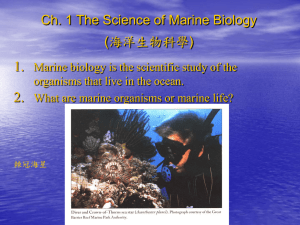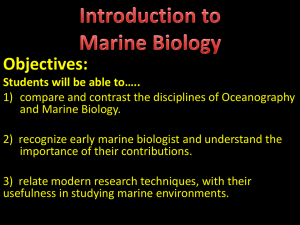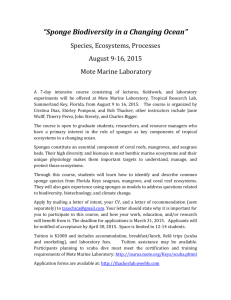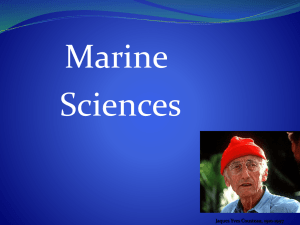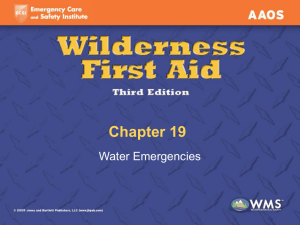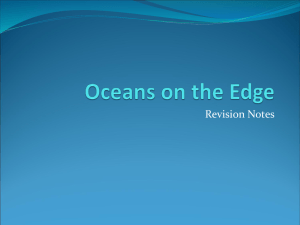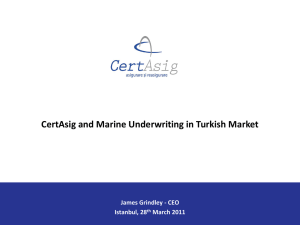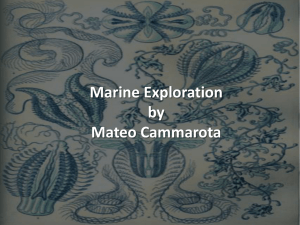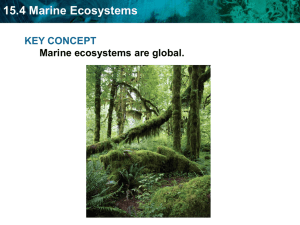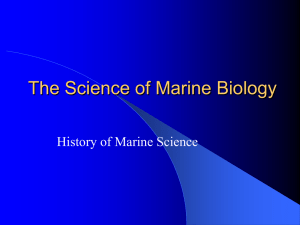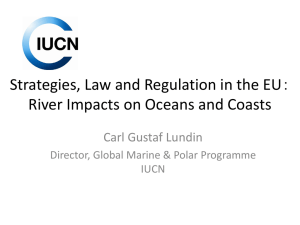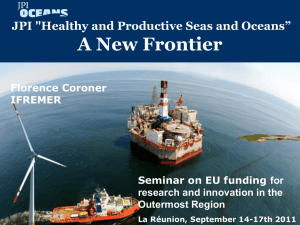HISTORY OF MARINE BIOLOGY
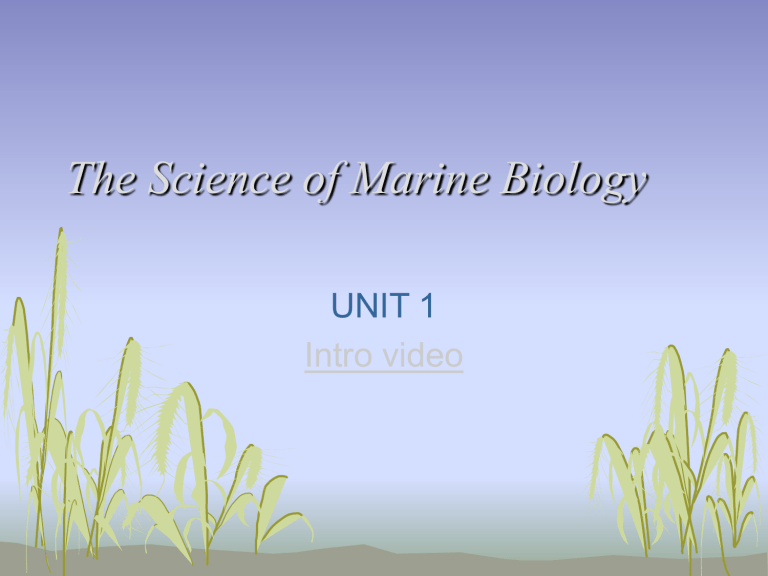
The Science of Marine Biology
UNIT 1
Intro video
What is Marine Biology
• Scientific study of organisms of the seas
• Marine bio video
What is Oceanography?
• Scientific study of the oceans
• Covers geology, chemistry, meterology, biology
• A biological oceanographer focuses on organisms in the deep while marine biologists tend to study organisms close to shore
Why study Marine Biology?
• Oceans hold a variety of life- adventurous to study
• Provides clues to Earth’s past
• Source of human wealth
• Food, medicines, raw materials, recreation
• Marine life helps to determine the nature of our planet- make oxygen
• To solve problems created by marine organisms- barnacles
History of Marine Biology
• Aristotle considered one of the first marine biologists
• He described many forms of marine life
• Recognized gills as the breathing organisms of fish
• The Greeks used mathematical principles for seafaring and created more accurate maps
• Knew Earth was a sphere
Latitude/longitude system
• Developed by Greeks
• Latitude = east-west
• Longitude = north-south
• In degrees
• 1 degree=60 minutes
• 1 minute = 60 seconds
• Latitude lines never intersect so called parallels- 0*parallel = equator
• Longitude lines called meridians- 0* meridian goes through the Royal Naval Observatory in
Greenwich, England (the prime meridian)
• Other cultures such as Egyptians,
Pacific Islanders, the Vikings and Arab traders also studied the oceans as well
• Early explorer video
• Polynesians underwent the earliest known regular long-distance, openocean out of sight of land voyages
Middle Ages (800 A.D -1400)
• A time of “intellectual darkness”
• Become an illiterate society
• Believed Earth was flat
• Only European voyages were Vikings
Viking Explorations
(790 A.D. – 1100)
• Established trade routes with Britain,
Ireland, Southern Europe, North Africa, and Central Asia.
• Discovered Iceland, Greenland and
North America (Newfoundland, Canada)
• Contributed to European ship design
Chinese Explorations
• Invented the magnetic compass (1125)
• Traded with Korea, Japan, and Australia
• Contributed central rudders and watertight compartments to ship building
European Explorations (1400-1700)
• Renaissance period- centered in Italy
• Ocean expeditions were conduced for economic, political and religious reasons
James Cook and the Birth of Marine
Science
• An English sea captain
• One of the first to make scientific observations on his travels and to include a full time naturalist
• Beginning in 1768, he explored all of the oceans
• Used the chronometer- an instrument that helped to determine his longitude and latitude and make accurate charts
• First European to see the Antarctic and to land in Hawaii, New Zealand, Tahiti and other Pacific islands.
• Killed in 1779 in a fight with native
Hawaiians at Kealakekua Bay Hawaii
• James Cook video
Charles Darwin
• English Naturalist on the Beagle -1831
• Described atolls- rings of coral reef
• Studied plankton and barnacles
United States Exploring Expedition
• 1838-1842
• The “Wilkes Expedition”
• 2 out of 6 ships returned
• Confirmed Antarctica was a continent
• Explored 280 islands
• Collected 2,000 unknown species
• video
Matthew Maury- Father of Physical
Oceanography
• US Naval Officer
• 1834-1841 3 world tours
• 1842 appointed superintendent of Dept of
Charts and Instruments of the Navy department
• Began publishing his work
• His system for recording oceanic data was adapted worldwide especially his studies of currents and winds
The Challenger Expedition- British
• First expedition entirely devoted to marine science- 1872 to 1876
• Sailed 80,778 miles
• Report took 23 years to complete
• Discovered the Mid-Atlantic ridge and the Marianas Trench
• Took the first soundings deeper than
4000 meters
• Discovered marine organisms in the deepest part of the ocean
• Sampled and illustrated plankton
• Catalogued and identified 715 new genera and 4717 new species
• NASA named space shuttle after it
• video
Oceanography Explosion
• Due to Industrial Revolution and the advancement of technology
• Rise of steam engines and iron ships
• Development of the diesel engine, electric motor and lead-acid battery lead to the development of submarines
• Wealthier countries = more research $ therefore applied research increased dramatically as well as pure research
• The Cold War and global conflict fueled scientific discovery
Important 20
th
Century Expeditions
• German Meteor expedition- 1925
• One of 1 st modern oceanographic research cruises
• Crossed Atlantic 14 times in two years
• Mapped Atlantic seafloor with echosounding technology- 1 st one of its kind
• Atlantis expedition- U.S.- 1931
• 1 st ship built specifically for ocean studies
• Confirmed and mapped the Mid-Atlantic
Ridge
• Space shuttle named after it
• New H.M.S. Challenger II1951
• 2 year voyage to the Atlantic, Pacific and Indian oceans
• Found deepest part of ocean (the
Challenger Deep) in the Marianas
Trench- 10, 838 meters
SUBMERSIBLES AND SELF-
CONTAINED DIVING
Submersibles
• 3 basic types
• 1. Bathysphere- developed by William
Beebe and Otis Barton in the 1930’s
• Steel ball with a window and an umbilical
• Only went vertically- attached by a cable to a ship
• 1932 Beebe and Barton reached 661 meters
The bathysphere (1930)
• 2. Bathyscaphe
• Similar to bathysphere except it was attached to a large float instead of to a cable and ship
• Limited horizontal motion because of propellers
• Deepest diving submersibles ever made
• Trieste traveled to the bottom of the
Challenger Deep
• 3. Deep-Diving submersibles
• 2-3 person vessels
• Moderate to deep depths
• Good horizontal movement
• No float tanks
• Less fragile
• Robotic arms
• Alvin most famous-discovered the Titanic -
Jason Project- operated by Woods Hole
Oceanographic Institute (US Navy)
Johnson Sealink Submersible
• Advantages of submersibles
• Great depths
• Duration of dives are longer
• Disadvantages of submersibles
• Very expensive
• Need of support vessels and diving teams
• Very large, so not able to have access to many places
Self-Contained Diving
• 1 st was hard-hat (helmet) diving-
Englishman named Augustus Siebe-
1840
• Good for underwater labor, not good for research because it was heavy and required a support team and vessel
• Englishman Henry Fleuss introduced the first workable scuba in 1878
• Recirculated pure oxygen which is only usuable to a depth of 10 meters or 33 ft
• Frenchman Jacques Cousteau and engineer
Emile Gagnan developed the scuba system used today in 1943
• Delivers compressed air and only provides it when the diver inhaled
• Easy to use, lightweight, simple, little support needed
• Advantages of SCUBA
• Less expensive
• Very simple- don’t need a team
• Portable and small
• More dexterity
• Disadvantages of SCUBA
• Usually limited to about 40-50 m (130-165 ft)-compressed air and to about 150 m with synthetic breathing gases
• Duration is smaller due to cold, pressure, and fatigue
Hardsuits - 1913
• In between a submersible and scuba
• More protection from temp. and pressure
• More mobile than submersibles
• Deeper dives
• Expensive
• Also need some team support as well
ROVs, AUVs, Electronic Navigation, and Satellites
ROVs
• “Remotely operated vehicle”
• Small unmanned submarine with propellers, video camera and an umbilical
• Operator at surface
• Can have arms, claws and other tools
AUVs
• “Autonomous Underwater Vehicle”
• Untethered robotic device
• Self-contained power systems
• Controlled by an attached computer
• Maneuverable in 3 dimensions
Electronic navigation
• 1 st was LORAN (Long Range Navigation)-
1960s
• Developed into Loran-C- based on radio signals from the coast- needed to triangulate to get ships position
• Accurate within a few meters
• But only worked where Loran transmitters were located
• Accuracy depended on distance from transmitter
GPS
• “Global Positioning System”- 1990s
• Developed by U.S. Military
• Receives signals from satellites
• Accurate within 1-2 meters
